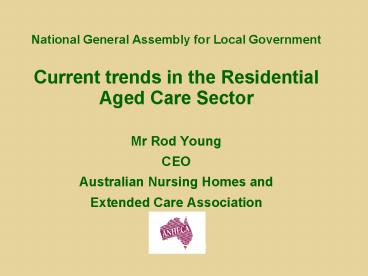National General Assembly for Local Government - PowerPoint PPT Presentation
1 / 17
Title:
National General Assembly for Local Government
Description:
PwC. National General Assembly for Local Government. Current trends in the ... 000 people received services through the Home and Community Care (HACC) program. ... – PowerPoint PPT presentation
Number of Views:24
Avg rating:3.0/5.0
Title: National General Assembly for Local Government
1
- National General Assembly for Local Government
- Current trends in the Residential
- Aged Care Sector
- Mr Rod Young
- CEO
- Australian Nursing Homes and
- Extended Care Association
2
The Residential Care Sector
2963 facilities 1450 providers
135,000 staff 145,000 operational residential
places 30,000 operational community places
3
History of the Sector
- Commonwealth funding responsibility
- Cottage industry till early 1990s
- 1997 major reform
- Corporate consolidation
- 60 / 40 voluntary/private operators
4
History of the Sectorcontd
- 60 less than 60 beds
- 2M business
- Totally dependent on Cth. subsidy
- Income inflexibility
5
Total cost of supplying aged care services,
2002-03 to 2042-43
6
Total cost of supplying formal aged care
services, by service stream, 2002-03 to 2042-43
7
The aged care group
In 2002-03, 184,095 people received permanent
residential care, 34,025 people receive
residential respite care, 31,186 received care
through a Community Aged Care Package (CACP), and
an estimated 700,000 people received services
through the Home and Community Care (HACC)
program. The profile of care recipients as at 30
June 2003 was
- Just over 50 per cent of aged care residents were
over the age of 85 - 72 per cent of residents were female
- 56 per cent of all female residents were over the
age of 85 - 37 per cent of male residents were over the age
of 85 - 90 per cent of residents were in receipt of a
full or part pension 74 per cent received a
Centrelink pension and 16 per cent received a DVA
pension and - 6,215 residents were under the aged of 65, or 4
per cent of all residents
8
Demographics, including future demand
Source ABS Cat. No. 3201.0 and 3222.0 from the
Econdata database (August 2000)
9
Growth in residential aged care
- Growth in residential aged care places is
controlled by the Department of Health and Ageing - Department has issued, on average, approx. 1355
new places each year since 1999
10
Ownership categories of aged care places
11
Current ownership structure of the industry
- Small facilities lt 60 places are more likely to
be operated by State governments, local
Government and community-based owned
organisations - Religious owners have an equal distribution for
facilities in all sizes - Private operators are more likely than other to
own large gt 80 places facilities.
Source DoHA, Review of Pricing Arrangements in
Residential Aged Care, 2003 Table 9.
12
Current distribution of facilities by size
- Only 12 of facilities are larger than 80 places
- Even the private sector has only 20 of places gt
80 places
Source DoHA, Review of Pricing Arrangements in
Residential Aged Care, 2003 Table 10.
13
Percentage of providers by number of homes
Source DoHA, Review of Pricing Arrangements in
Residential Aged Care, 2003 Table 12a.
14
Distribution of aged care homes by size
Source DoHA, Review of Pricing Arrangements in
Residential Aged Care, 2003 Table 12b.
15
Growth in the value of new accommodation bonds
- Average value of bonds has increased by 40,000
since 1999 - Currently bonds limited to low care and extra
service places
Source DoHA, Report of Operation othe Aged Care
Act 1997 1999-2003
16
Labour costs as a ratio of total expenses by state
Note State-owned entities includes ACT
includes NT the small number of observations
calls for cautious interpretation
17
(No Transcript)






























![Maharashtra National Law University – [MNLU], Nagpur PowerPoint PPT Presentation](https://s3.amazonaws.com/images.powershow.com/9671532.th0.jpg?_=20211013027)